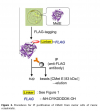Ferrostatin 1 (Fer-1)
Ferrostatin-1 (Fer-1) is a potent inhibitor of ferroptosis, a type of iron-dependent cell death implicated in various kidney diseases, including hyperuricemic nephropathy (HN). HN is a metabolic disorder characterized by elevated uric acid levels, leading to renal fibrosis and tubular necrosis.
Agomelatine
A Novel Therapeutic Agent for Rheumatoid Arthritis, Agomelatine (AOM) is a promising pharmacological agent that has shown significant therapeutic potential in combating rheumatoid arthritis (RA), a chronic autoimmune disease characterized by inflammation and joint destruction. Recent studies have revealed AOM's efficacy in inhibiting tumor necrosis factor-alpha (TNFα) -mediated inflammation, a crucial pathway involved in RA pathogenesis.
Cinacalcet
Cinacalcet an FDA approved drug which kills bacteria by destroying bacterial membrane as well as respiratory metabolism and is used to treat secondary hyperparathyroidism and parathyroid cancer. It can also kill bacteria by producing reactive oxygen species (ROS). It was revealed by Limited Proteolysis -Small molecule mapping (LiP-SMap) that cinacalcet inhibits biofilm formation by targeting IcaR. Cinacalcet can partially remove the biofilm of drug-resistant S. aureus in an animal model it was revealed by in vitro and in vivo experiments . These findings suggest that cinacalcet has antibacterial and antibiofilm capabilities.
Ademetionine
A ubiquitous metabolite that participates in numerous physiological processes, including transsulfuration, polyamine biosynthesis, and transmethylation is the ademetionine also known as S-adenosyl-L-methionine (AdoMet), SAM or SAMe ( Glpbio ).
Tylosin/Tylosin A
A macrolide antibiotic, tylosin is active against gram-positive aerobic bacteria and mycoplasmas throughout a wide range of conditions. It is authorized for the treatment of a number of infectious disorders in cattle and poultry, including mastitis, respiratory conditions, and farm animal dysentery.
Sedanolide
Naturally occurring phthalide-like compound derived from celery seed oil is the sedanolide( Glpbio) which has antifungal , mosquitocidal and anti nematodal properties . Sedanolide has been shown to exert antioxidant effects by increasing glutathione S-transferase (GST) activity and by inhibiting tumor incidence .Nuclear factor E2-related factor 2 (NRF2) pathway is activated by sedanolide to protect mice from acetaminophen-induced liver injury and it is also associated with bacteria such as Lactobacillus.
RSM-932A
Introduction: RSM-932A, also known as TCD- 717, is a ChoKα asset, which targets the mortal choline kinase nascence, an enzyme involved in increased lipid metabolism of cancer cells. RSM-932A appears to have an altogether new medium of inhibition and is synergistic with respect to both choline and ATP. RSM-932A have in vitro inhibitory exertion in the low nanomolar range.
Sodium Palmitate
The sodium salt of palmitic acid, sodium palmitate ( Hexadecanoic acid sodium salt, Palmitic acid sodium salt) , produced during the process of fatty acid synthesis present in fats and waxes. It is produced synthetically and driven by palm oil. Plays major role as an emulsifier.
Ferroptosis, an article published in the journal Cell gives you an insight into this hot research area
Brent R. Stockwell, the author of the origin of Ferroptosis, has written a review about research progress for the 10th anniversary of Ferroptosis, published in the journal Cell with a high impact factor of 66.85 (2022). The National Nature Foundation projects and the amount of money winning the bid in this direction are rising year by year, and the relevant research papers are also repeatedly topping the CNS! (Figure 1)




















